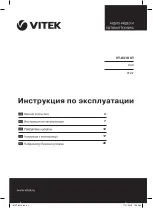
4
ENGLISH
•
Before switching the iron on, make sure that
your home mains voltage corresponds to the
iron operating voltage.
•
There may be water residue in the tank,
this is normal, as the iron has undergone
factory quality control.
Note: When the iron is switched on for the first
time, the heating element of the iron burns,
therefore occurrence of foreign smell and a small
amount of smoke is possible, it is normal.
WATER SELECTION
Use tap water to fill the tank. If tap water is hard,
it is recommended to mix it with distilled water in
proportion 1:1, if tap water is too hard, mix it with
distilled water in proportion 1:2 or use distilled
water only.
FILLING THE WATER TANK
Before filling the iron with water, make sure that
it is unplugged.
•
Set the temperature control knob (12) to the
position «
OFF», and the continuous steam
supply knob (3) to the position « »
.
•
Open the water inlet lid (2).
•
Pour water into the water tank (10) using the
beaker (15) and then close the lid (2).
Notes:
–
Do not pour water over the “max” mark (14).
–
If you need to refill water during ironing, switch
the iron off and unplug it.
–
After you finish ironing, switch the unit off, wait
until it cools down completely, then open the
water inlet lid (2), turn over the iron and drain
the remaining water.
IRONING TEMPERATURE
Before operation, test the heated iron on a piece
of cloth to be sure that the iron soleplate (11) and
the water tank (10) are clean.
•
Always check the recommended ironing tem-
perature indicated on the tag before ironing.
•
If there is no tag with recommended ironing
temperature, but you know the type of fabric,
refer to the following table to determine the
proper temperature.
FABRIC TYPE ICONS (TEMPERATURE)
•
Synthetics, nylon, acrylic,
polyester (low temperature)
••
Silk/wool (medium temperature)
•••
(МАХ)
Cotton/linen (high temperature)
•
This table is only valid for smooth materials.
Fabrics of other types (crimped, raised, etc.)
are best ironed at low temperature.
•
First sort items by ironing temperature: syn-
thetics to synthetics, wool to wool, cotton to
cotton etc.
•
The iron heats up faster than it cools down.
For this reason, it is recommended to begin
ironing at low temperature (for instance,
synthetic fabrics). After that, start ironing at
higher temperature (silk/wool). Cotton and
linen items should be ironed last.
•
If an item is made of mixed fabrics, the iron
should be set to the lowest ironing temper-
ature (for instance, if an item is made of
polyester and cotton, it should be ironed at
temperature used for polyester ironing «•»).
•
If you cannot define the fabric structure, find
a spot that is inconspicuous when the item is
being worn and select the ironing temperature
experimentally (always start with the lowest
temperature and raise it gradually until you get
the desired result).
•
Corduroy and other fabrics that become
glossy quickly should be ironed strictly in
one direction (in the direction of the pile) with
slight pressure.
•
To avoid appearance of glossy spots on syn-
thetic and silk fabrics, iron them backside.
DRY IRONING
•
Place the iron on its base (8).
•
Insert the power plug into the mains socket.
•
Set the steam supply knob (3) to the position « »
(continuous steam supply is off).
•
Turn the knob (12) to set the required iron-
ing temperature: “
•
”, “
••
”, “
•••
” or “
MAX
”
(depending on the type of fabric), the indica-
tor (5) will light up.
•
Once the soleplate (11) reaches the set tem-
perature, the indicator (5) will go out and you
can start ironing.
•
After you finish ironing, set the temperature
control knob (12) to the “
OFF
” position.
•
Pull the power plug out of the mains socket
and let the iron cool down completely.
STEAM IRONING
The iron is provided with an anti-drip valve that
stops water supply if the soleplate temperature
is too low; it prevents dripping from the soleplate
openings (11). During heating and cooling of the
iron soleplate, you will hear characteristic clicks
IM VT-8318.indd 4
17.11.2016 10:53:42





































